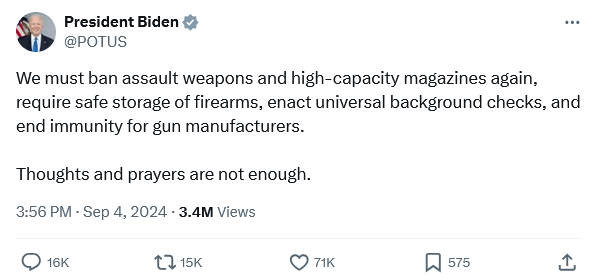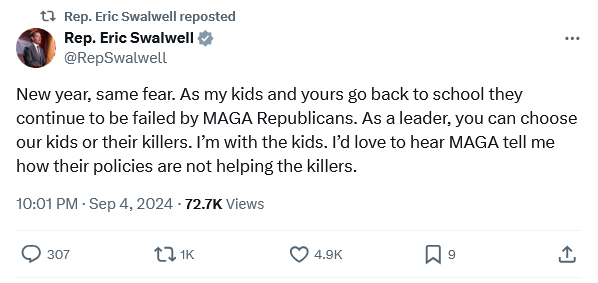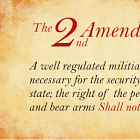Can We For Once Talk Seriously About Mental Health?
Whatever Else Colt Gray Is, He Is A Child In Crisis. That Should Still Matter
Yet another tragic school shooting.
Yet more lives lost.
Yet more proof that these shooters do not emerge fully formed out of the ether. They are months and years in the making, while people stand by and watch them deteriorate. While nothing gets done. While another child, another human being, somehow falls through the cracks.
No matter what else emerges in the days and weeks to follow after yesterday’s shooting at Apalachee High School in Barrow County, Georgia, we already know that much.
Now it has emerged that the FBI and the police had interviewed Gray and his father in May 2023 over “online threats to commit a school shooting,” which contained photographs of guns, the FBI’s Atlanta office said in a statement.
After receiving several anonymous tips, the FBI confirmed the online threats originated from Georgia and referred the information to the Jackson County Sheriffs’ Office.
More than one year ago, “several” people noticed that Colt Gray was is crisis. The FBI has already confirmed this to be the case.
Yet here we are. People dead. Lives shattered.
Let me be clear: I do not know what mental or emotional health struggles Colt Gray has. I do not consider any of them to excuse or mitigate what he is accused of doing. Whatever demons lurk inside of him, killing others is not a means for handling them. Violence is not a solution to mental health.
Taking a weapon into his school was an evil act, and he must now answer for that evil act. That is what should happen, and that appears to be what will happen.
However, we already know that Colt Gray is not unique in the world. We already know that there are troubled youths out there. Will we stand by and let those troubled youths also deteriorate to the point where violence seems permissible, where killing somehow becomes a solution?
Can we now admit to ourselves that the warning signs have been there that Colt Gray was a young man headed for a troubled ending? That those warning signs, if heeded, could have changed that ending?
Let me clear again: We know Colt Gray was a troubled youth. We know he was expressing some very intense rage one year ago. An intervention at that time to remediate that rage would have absolutely prevented this tragedy. The lives that were lost could have been saved.
Nor was it simply a case of a single FBI incident. Even his own classmates concede they were aware he was a troubled youth.
Student Lyela Sayarath told CNN that she wasn’t surprised when she heard Gray was the suspected gunman because he fitted the description of a shooter.
“He wasn’t there most times,” Sayarath said. “He either wouldn’t be there or skip class. But even when he would’ve talked, it was one-word answers and short statements.”
How does any high school student become so cynical and so callous as to simply shrug off another human being as “fitting the description of a shooter”? How can it be that obvious that someone is in crisis and yet things continue on their tragic course?
To be sure, the reporting does indicate that Gray’s family was in contact with the family services agencies for their community.
It was also revealed that Gray and his family had contact with the department of family and children’s services in the area, which authorities are pursuing as another a line of inquiry.
Gray has been described by a classmate as “quiet” student who would often “skip class”.
Take a moment to consider these observations made off the cuff by those around Apalachee High School: Colt Gray was “quiet”. Colt Gray skipped class often. Colt Gray was minimally engaged with his classes and apparently with his classmates as well.
The term to be applied here is “social isolation”. Whatever else was going on in Colt Gray’s life, what the witnesses to this tragedy have already said is that Colt Gray was a socially isolated youth.
We do not need to speculate if social isolation is a mental health problem. That question has been answered in abundance.
Social isolation is not merely a mental health problem. Studies show that social isolation in children has lifelong consequences1.
Socially isolated children had higher levels of C-reactive protein in mid-life (standardized coefficient=0.05, p≤0.001). In addition, children who were socially isolated tended to have lower subsequent educational attainment, be in a less advantaged social class in adulthood, were more likely to be psychologically distressed across adulthood and were more likely to be obese and to smoke. All of these factors partially explained the association between childhood social isolation and CRP. However, this association remained statistically significant after considering all mediators simultaneously.
Studies have shown that even among adults, social isolation can have neurological consequences2.
Research also shows that even teens recognize that social isolation is frequently a response to life stressors—and not a good response, either3:
Taking the perspective of one student, he described the stress experience in the following way:
So, me, personally, when I see my stress, I'd talk to you in a different way. I'm usually an energetic, annoying person sometimes. But if I'm really stressed, I won't talk to you at all. I really won't talk to you, or I'd be wanting to leave school early, something like that.
From his perspective, he is able to identify a physiological marker of when stress is present by noting that his disposition changed. He is normally an outgoing student but notices he becomes more guarded and closed off when stressed. He also did not identify any adaptive ability he used to manage stress other than to withdraw from his peers, which is a primitive response to stress akin to the “flight” response from “flight or fight” theory. When asked to describe what stress looks like when it happens to his peers, he again named observed behaviors:
When I see my other friends who are stressed, I can tell because of their body language. So, I have a friend who's... he's cool and he's funny, stuff like that. But whenever he has stress, he doesn't talk, or he'll just give you a one-word answer if you ask him a question. So, that's how I could tell he's stressed.
Students are aware of behavioral changes in their peers. As other students shared their experiences with stress, the theme of observed mood changes and a desire to isolate continued to be a common talking point:
I pretty much just put on my headphones. I try and block people out when I'm stressed because everything just sends me over the edge. My moods are different. I'm just irritated with everything and everyone for no reason. Obviously, there's a reason. But just body language you can tell when people, when they're stressed, they're just different. Most cases, what I've noticed with my friends, they try to isolate themselves, to be themselves and deal with it, and they're not actually dealing with it.
This student recognizes stress occurring and shares that she and her friends often prefer to isolate when dealing with stress but there is recognition by this student that withdrawing and isolating may not be the best method for managing stress.
For decades, research has shown that loneliness and social isolation correlate to depression among adolescents4. Research has also shown that, not infrequently, loneliness is a cause of major depression among adolescents5.
Our results suggest that enduring peer-related loneliness during childhood constitutes an interpersonal stressor that predisposes children to adolescent depressive symptoms.
While it might seem extravagant to extrapolate major depressive illness from a handful of ad hoc observations, bear in mind these observations come from people who experienced Colt Gray daily. These were the casual observations of those who had casually observed Colt Gray for at least the past year.
Those casual observations are all consistent with signs and predictors of major depressive illness. They should have been red flags to everyone around Colt Gray that “something” was wrong, that he wasn’t doing well, and that he was heading into crisis if not already in crisis.
Those casual observations, along with the FBI notice and the investigation last year by the Jackson County Sheriff’s Office, all lead to the same inescapable conclusion:
THE PEOPLE AROUND COLT GRAY KNEW HE WAS A TROUBLED TEEN!
People knew, and still he slipped through the cracks, his issues either not noticed or insufficiently noticed.
Unsurprisingly, we do not hear about mental health from political leaders in response to this tragedy. All we get is more pious pontifications about gun control.
We get useless finger pointing at other political leaders.
These are worse than useless statements to make. They are stupid statements to make—government does not have the Constitutional authority to disarm people and render everyone helpless.
Even if one wishes to argue that the right to keep and bear arms is not an unlimited right, nowhere in the Constitution does it empower any level of government to decide what those limits should be—which means government does not get to decide what those limits should be. Until such time as the Constitution is amended to give government that authority, gun control talk is simply not rational. Until the Second Amendment is itself amended, there is no “common sense” regulation of the right to keep and bear arms.
There is, however, much that can be said about loneliness. I’ve said some of it here on this Substack.
Others are commenting about it as well. Unfortunately, the discussion that gets had revolves around deciding who is more troubled—a perverse olympiad of mental health crisis, which teens appear to be losing.
Of course, being a teen isn’t easy either. Depression and anxiety are increasing among adolescents. But in high school, you’re more likely to have people keeping an eye on you, who’ll notice if you’re upset at home or if you don’t show up to school. Adults know that they should protect you, and they have some power to do it, Weissbourd said.
We can say just on what few facts we have that the adults around Colt Gray failed to protect those whom he is accused of killing—which means the adults around Colt Gray failed to protect Colt Gray as well.
We know this because the witness statements are already showing that those around Colt Gray knew he was troubled. They knew, and yet still allowed this situation to develop.
Some might say I am trying to excuse what Colt Gray did. That is true. Colt Gray stands accused of murder, he will be tried as an adult, and, at this juncture, that is what needs to happen. No matter what brought him to make the evil choice he did, it was an evil choice and he must receive the full measure of consequence for that choice.
Some might also say that I am being too harsh on the teachers at his school, or his parents. No, I am not. Even if they claim “they didn’t know”, the reality of public schools and parenting is that it is their obligation to know. If even his classmates can be casually aware of the signs and symptoms of a teen in crisis, it is not credible in the slightest for the teachers and the parents to be blissfully unaware of those same signs and symptoms.
The reality of today’s youth is that they are as a generation in mental health crisis. The data shows that unambiguously, and that younger generations in this country are progressively less able to cope with life’s challenges than older generations.
While I do not know and will not speculate if Colt Gray suffers from any form of Post Traumatic Stress Disorder, it surely is an important perspective on the emotional and mental health challenges facing today’s youth to realize that this country has as many children grappling with PTSD as it does soldiers returning from combat with PTSD.
Whatever “solutions” we think we’re putting forward on adolescent and teen mental health, or just on people’s mental health in general, they are not proving to be up to the challenge. Whatever solution one wishes to highlight as being something being done about these issues—it’s not enough. Either more is needed, or a different approach is needed. Either way, the status quo should not be deemed acceptable, not even for a second.
It is too late to intervene to assist Colt Gray. That train has tragically left the station.
It is not too late to learn the lesson that each and every one of these tragic events arguably has been trying to teach us for years: The kids are not alright.
Our children are not doing well.
Our children are not thriving.
We see the signs of mental health crisis. We see the symptoms of mental health crisis. Even as teens we casually concede that we know the signs and symptoms of mental health crisis are, in fact, signs and symtpoms of mental health crisis.
Why are we not, as a society, confronting these signs and symptoms? Why are we not, as a society, realizing that our friends and our neighbors are spiralling down into crisis, even as we watch it happen? Why do we continue to rationalize and excuse inaction when people are spiralling down into crisis, only to splutter with feigned rage when that crisis then explodes all over corporate media?
I know we are capable of better than this.
I want to believe we want to better than this.
We absolutely have got to become better than this. If we want these tragedies to stop for good, the challenge is on us to become a whole lot better than this.
Lacey, Rebecca E et al. “Social isolation in childhood and adult inflammation: evidence from the National Child Development Study.” Psychoneuroendocrinology vol. 50 (2014): 85-94. doi:10.1016/j.psyneuen.2014.08.007
Cacioppo, Stephanie et al. “Toward a neurology of loneliness.” Psychological bulletin vol. 140,6 (2014): 1464-504. doi:10.1037/a0037618
DeWitt, W. P. (2020). Teen Stress and the High School Experience: Fostering the Adaptive Abilities to Survive and Advance. Graduate Theses and Dissertations Retrieved from https://scholarworks.uark.edu/etd/3581
Lau, S et al. “Facets of loneliness and depression among Chinese children and adolescents.” The Journal of social psychology vol. 139,6 (1999): 713-29. doi:10.1080/00224549909598251
Pamela Qualter, Stephen L. Brown, Penny Munn, Ken J. Rotenberg. Childhood loneliness as a predictor of adolescent depressive symptoms: an 8-year longitudinal study. European Child and Adolescent Psychiatry, 2009, 19 (6), pp.493-501. 10.1007/s00787-009-0059-y. hal-00535175










Mental health is a difficult issue for adults and children. Unfortunately, one cannot just call "someone" (police, whoever) and say, "Hey, I think this guy is doing really badly and may shoot up a school". As you see in this case, that was done, yet a year later, it still happened. It is VERY difficult to force someone, even a minor, to get help. There are limits on what you can do. You can send them to a psychiatrist, but if they don't want to go, you can't really make them. And even if you do, you can't force them to cooperate. You may be able to have them committed for a very short time, but they will get out in a couple days at most. Even parents have little control over the situation, but those who aren't parents have almost none. Until and unless you "catch" someone performing an illegal act, the police cannot come and take them away. Such things happen all the time. You see ex-spouses and ex-girlfriends getting threatened or beaten, they get a restraining order, the guy comes back and kills them, then gets arrested. I don't know what the answer is. Recognizing a problem and being able to eliminate it are two very different things. Probably the best thing is prevention. This means better family life, better diet, less gaming and internet, more outdoor activity, more physical education, and less glorification of violence by the same Hollywood people who claim we need "gun control" to reduce violence.
Question that could be answered. Was Colt on SSRIs. ? A common element of these sprees. Serotonin is not the happy molecule the medical community promotes but is highly dangerous but highly lucrative making Doctors and pHarma rich. We are sacrificing our children in so many ways.